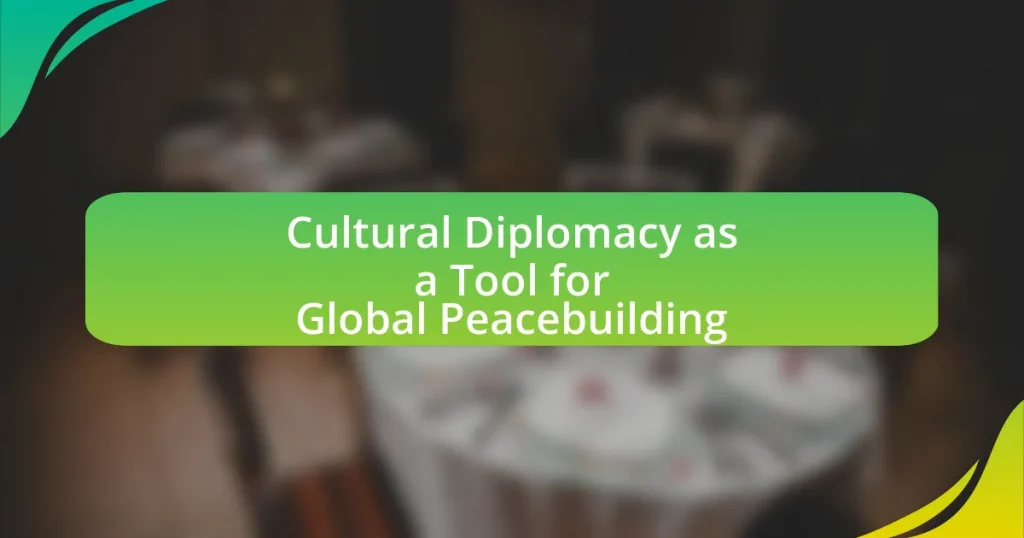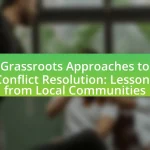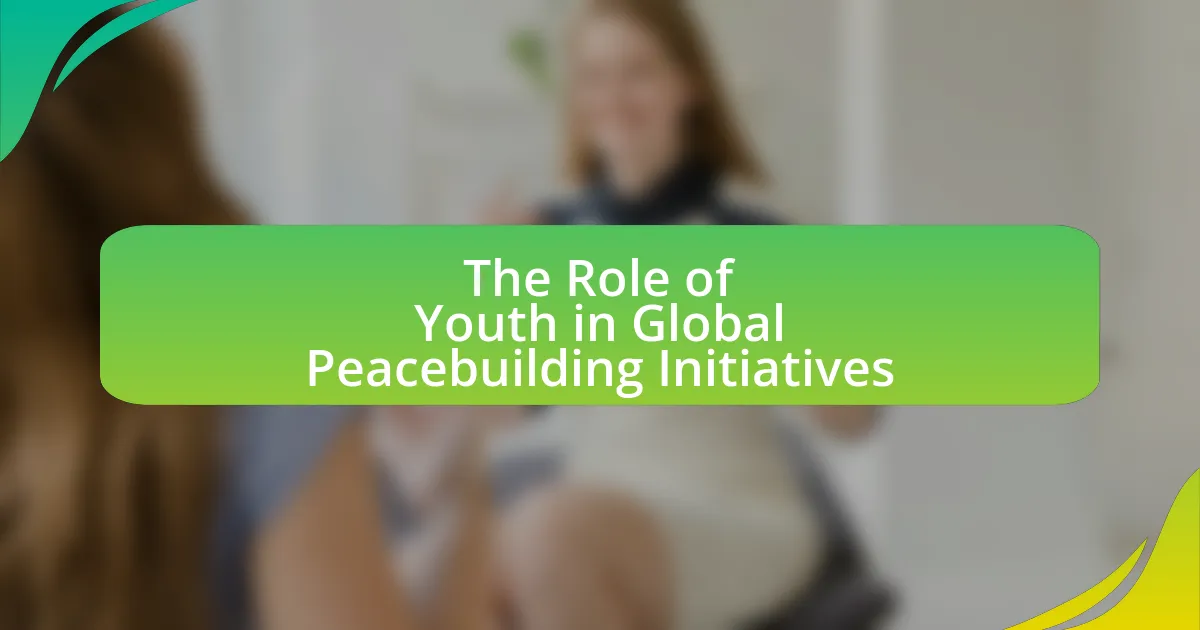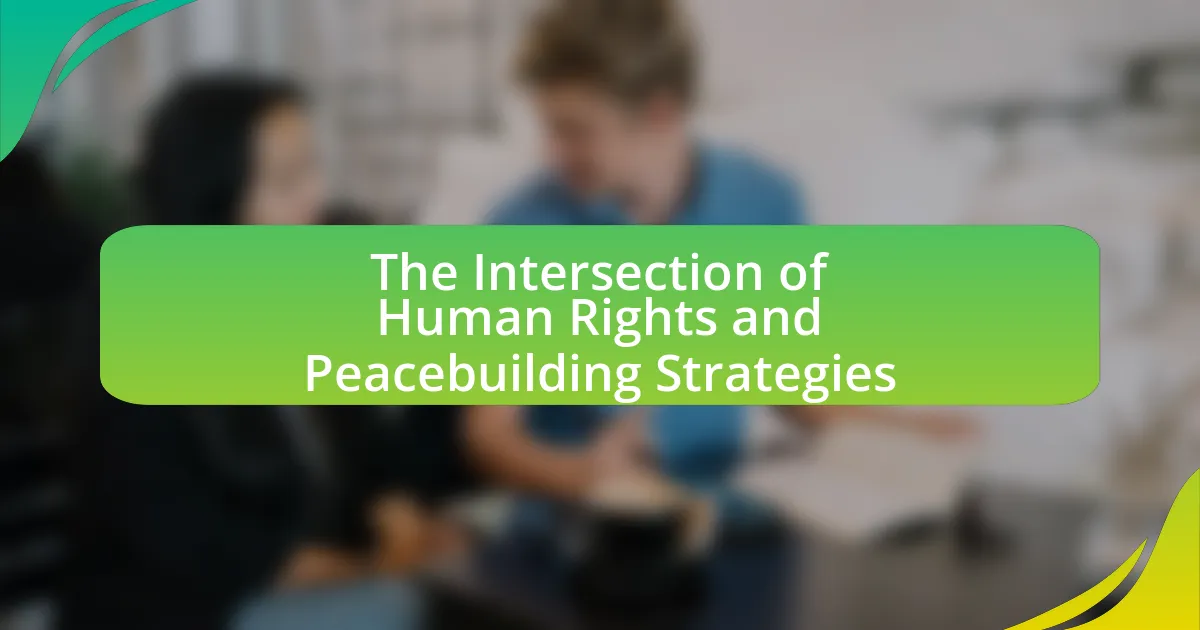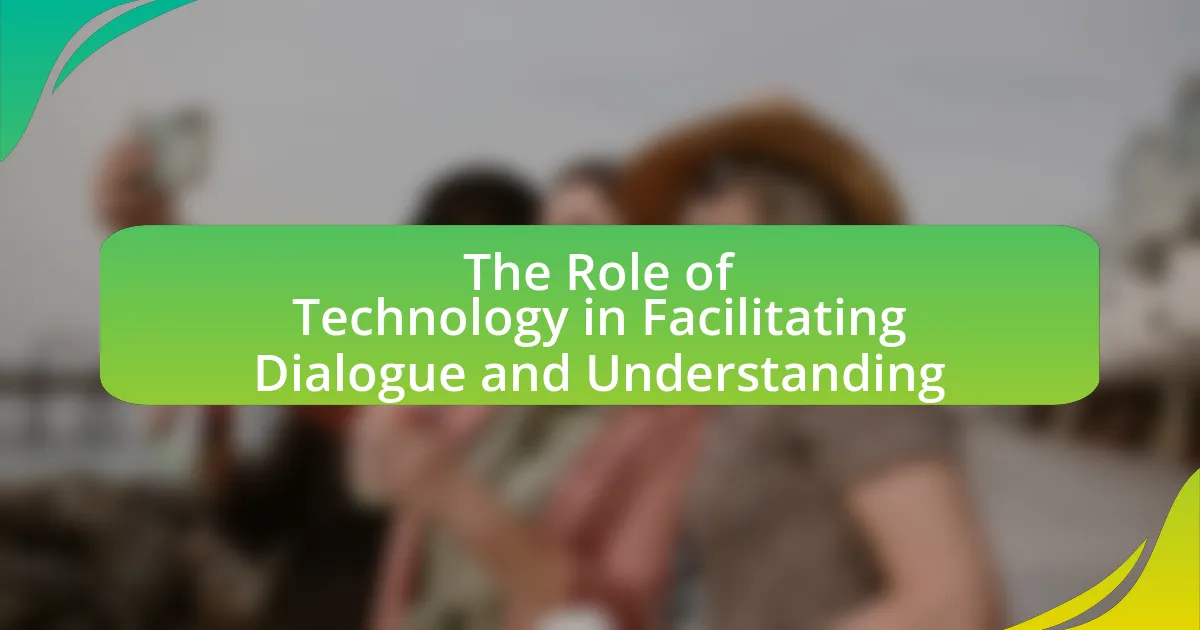Cultural diplomacy is the practice of utilizing cultural exchanges and initiatives to enhance mutual understanding and cooperation between nations, playing a crucial role in global peacebuilding. This article explores how cultural diplomacy fosters international relations by promoting dialogue, reducing tensions, and building trust through shared cultural experiences. Key principles such as mutual understanding, respect for diversity, and open communication are examined, alongside historical examples that illustrate its impact on peace. Additionally, the article discusses the mechanisms of cultural diplomacy, the effectiveness of various cultural programs, and the roles of governments and NGOs in facilitating these initiatives.
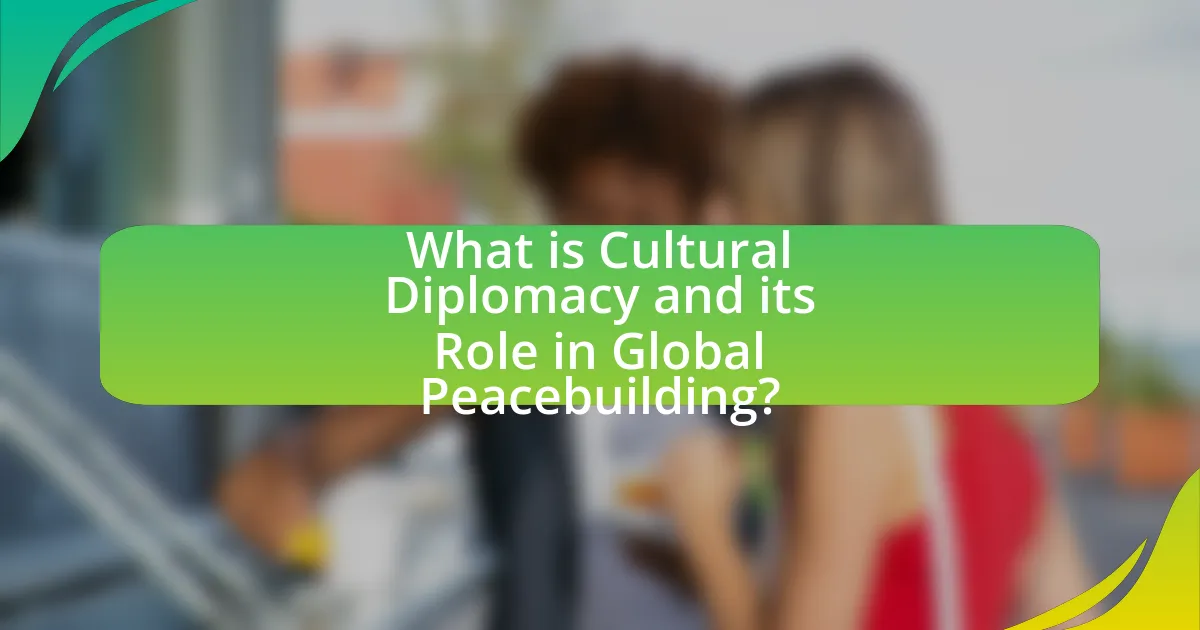
What is Cultural Diplomacy and its Role in Global Peacebuilding?
Cultural diplomacy is the practice of using cultural exchanges and initiatives to foster mutual understanding and cooperation between nations. Its role in global peacebuilding is significant, as it helps to bridge cultural divides, reduce tensions, and promote dialogue among diverse groups. For instance, programs like international art exhibitions and educational exchanges have been shown to enhance relationships between countries by highlighting shared values and fostering empathy. Research indicates that cultural diplomacy can lead to improved international relations, as evidenced by the success of initiatives such as the U.S. State Department’s cultural programs, which have historically contributed to diplomatic efforts and conflict resolution.
How does Cultural Diplomacy contribute to international relations?
Cultural diplomacy contributes to international relations by fostering mutual understanding and respect among nations through cultural exchange and dialogue. This approach enhances soft power, allowing countries to influence others positively without coercion. For instance, initiatives like the Fulbright Program and international art exhibitions promote cross-cultural interactions, which can lead to improved diplomatic ties and conflict resolution. Research indicates that cultural diplomacy can reduce tensions and build trust, as seen in the post-World War II era when cultural exchanges helped rebuild relationships between the United States and European nations.
What are the key principles of Cultural Diplomacy?
The key principles of Cultural Diplomacy include mutual understanding, respect for diversity, and the promotion of dialogue. Mutual understanding fosters relationships between nations by encouraging the exchange of cultural values and ideas, which can reduce tensions and build trust. Respect for diversity acknowledges the unique cultural identities of different societies, promoting inclusivity and cooperation. The promotion of dialogue facilitates open communication, allowing for the resolution of conflicts and the enhancement of international relations. These principles are essential for leveraging cultural diplomacy as an effective tool for global peacebuilding, as evidenced by various international initiatives that have successfully utilized cultural exchanges to bridge divides and foster collaboration among nations.
How does Cultural Diplomacy differ from traditional diplomacy?
Cultural diplomacy differs from traditional diplomacy primarily in its focus on cultural exchange rather than political negotiation. While traditional diplomacy often involves formal agreements and state-to-state interactions aimed at resolving conflicts or advancing national interests, cultural diplomacy emphasizes building relationships through shared cultural experiences, arts, education, and mutual understanding. This approach fosters long-term connections and soft power, as seen in initiatives like the Fulbright Program, which promotes educational exchanges to enhance international cooperation and goodwill.
Why is Cultural Diplomacy important for peacebuilding?
Cultural diplomacy is important for peacebuilding because it fosters mutual understanding and respect among diverse cultures, which is essential for conflict resolution. By promoting dialogue through cultural exchanges, art, and education, cultural diplomacy helps to break down stereotypes and build trust between nations. For instance, initiatives like the United Nations Educational, Scientific and Cultural Organization (UNESCO) emphasize the role of culture in promoting peace, highlighting that cultural engagement can reduce tensions and encourage collaboration. This approach has been evidenced in various peace processes, where cultural initiatives have successfully bridged divides and facilitated communication, ultimately contributing to more sustainable peace outcomes.
What historical examples illustrate the impact of Cultural Diplomacy on peace?
Cultural diplomacy has historically played a significant role in fostering peace, with notable examples including the U.S. cultural exchanges during the Cold War and the post-World War II initiatives in Europe. The U.S. implemented cultural exchange programs, such as the Fulbright Program, which aimed to promote mutual understanding and reduce tensions between nations. These exchanges allowed individuals from different countries to engage in dialogue, share ideas, and build relationships, contributing to a more peaceful international environment.
Another example is the European Union’s promotion of cultural diplomacy through initiatives like the European Capital of Culture program, which encourages cultural collaboration among member states. This program has successfully fostered unity and understanding among diverse cultures, helping to mitigate historical conflicts and promote peace in the region.
Additionally, the role of art and music in diplomacy, such as the “Ping Pong Diplomacy” between the U.S. and China in the 1970s, illustrates how cultural engagement can lead to improved relations and peaceful resolutions. These historical instances demonstrate that cultural diplomacy can effectively bridge divides and promote peace on a global scale.
How does Cultural Diplomacy foster mutual understanding among nations?
Cultural diplomacy fosters mutual understanding among nations by promoting dialogue and exchange through cultural initiatives, which help bridge differences and build relationships. For instance, programs such as international art exhibitions, music festivals, and educational exchanges allow individuals from diverse backgrounds to share their cultural heritage and perspectives. This interaction can lead to increased empathy and respect, as evidenced by the success of initiatives like the U.S. State Department’s Arts Envoy program, which has facilitated cultural exchanges in over 100 countries, enhancing cross-cultural communication and understanding.
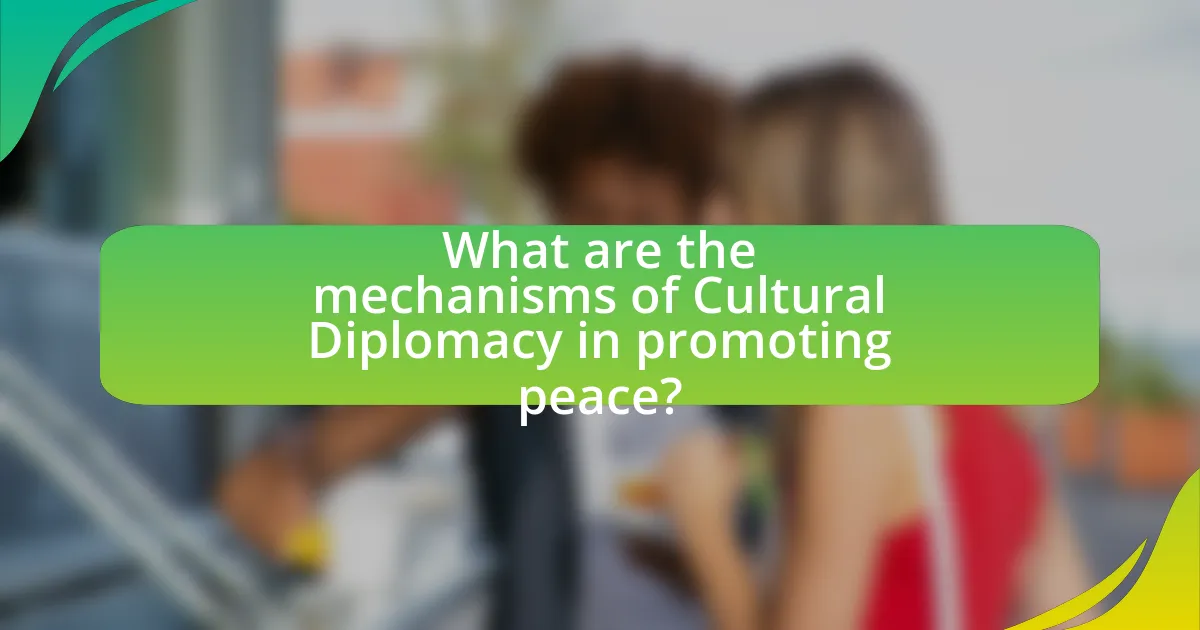
What are the mechanisms of Cultural Diplomacy in promoting peace?
Cultural diplomacy promotes peace through mechanisms such as cultural exchanges, educational programs, and collaborative artistic initiatives. These mechanisms facilitate mutual understanding and respect among diverse cultures, which are essential for conflict resolution. For instance, cultural exchanges allow individuals from different backgrounds to share their traditions and values, fostering empathy and reducing stereotypes. Educational programs, like international scholarships, enable students to study abroad, promoting cross-cultural dialogue and cooperation. Collaborative artistic initiatives, such as joint exhibitions or performances, create shared experiences that can bridge divides and encourage peaceful interactions. Historical examples, such as the U.S. State Department’s Arts Envoy program, demonstrate how cultural diplomacy has successfully built relationships and promoted peace through the arts.
How do cultural exchanges facilitate dialogue between conflicting parties?
Cultural exchanges facilitate dialogue between conflicting parties by promoting mutual understanding and empathy through shared experiences. These exchanges allow individuals from different backgrounds to engage in direct communication, fostering personal connections that can transcend political or ideological divides. For instance, programs like the U.S. State Department’s International Visitor Leadership Program have successfully brought together participants from various nations, enabling them to discuss their perspectives and cultural practices. Research indicates that such interactions can reduce stereotypes and build trust, as evidenced by a study published in the Journal of Peace Research, which found that cultural diplomacy initiatives significantly lower tensions between conflicting groups.
What types of cultural programs are most effective in peacebuilding?
Cultural programs that are most effective in peacebuilding include intercultural exchanges, collaborative art projects, and community-based dialogue initiatives. Intercultural exchanges foster understanding by allowing individuals from different backgrounds to share experiences and perspectives, which has been shown to reduce prejudice and promote empathy. Collaborative art projects, such as murals or performances, create shared spaces for expression and dialogue, facilitating connections among diverse groups. Community-based dialogue initiatives, like peace circles or workshops, encourage open communication and conflict resolution, leading to stronger community ties. Research indicates that these types of programs can significantly enhance social cohesion and contribute to long-term peace, as evidenced by successful initiatives in post-conflict regions like Rwanda and Bosnia.
How can art and literature serve as tools for Cultural Diplomacy?
Art and literature serve as tools for cultural diplomacy by fostering mutual understanding and dialogue between nations. Through artistic expression and literary works, diverse cultures can share their values, histories, and perspectives, which helps to break down stereotypes and build empathy. For instance, initiatives like the International Literature Festival in Berlin promote cross-cultural exchange by featuring authors from various countries, allowing audiences to engage with different narratives and experiences. Additionally, art exhibitions, such as the Venice Biennale, often include works from multiple countries, encouraging collaboration and conversation among artists and viewers. These platforms demonstrate how art and literature can transcend language barriers and facilitate peaceful interactions, ultimately contributing to global peacebuilding efforts.
What role do governments and NGOs play in Cultural Diplomacy?
Governments and NGOs play a crucial role in cultural diplomacy by facilitating international dialogue and fostering mutual understanding through cultural exchanges and programs. Governments often utilize cultural diplomacy to promote national interests, enhance soft power, and build relationships with other nations, as seen in initiatives like the U.S. State Department’s cultural exchange programs that aim to improve international perceptions. NGOs complement these efforts by implementing grassroots initiatives that promote cultural awareness and cooperation, such as the work of organizations like the British Council, which engages in educational and cultural projects worldwide to strengthen ties between the UK and other countries. Together, these entities contribute to global peacebuilding by creating platforms for collaboration and dialogue, ultimately reducing tensions and fostering a sense of community among diverse cultures.
How can partnerships enhance the effectiveness of Cultural Diplomacy initiatives?
Partnerships can enhance the effectiveness of Cultural Diplomacy initiatives by leveraging diverse resources, expertise, and networks to create more impactful programs. Collaborative efforts between governments, NGOs, and cultural institutions can amplify outreach and engagement, as seen in initiatives like the U.S. State Department’s Cultural Programs, which partner with local organizations to foster cross-cultural understanding. These partnerships enable the sharing of best practices and innovative approaches, ultimately leading to more sustainable and meaningful cultural exchanges that contribute to global peacebuilding efforts.
What challenges do organizations face in implementing Cultural Diplomacy?
Organizations face several challenges in implementing Cultural Diplomacy, including political resistance, cultural misunderstandings, and resource limitations. Political resistance often arises from differing national interests or ideologies that can hinder collaborative efforts. Cultural misunderstandings can lead to misinterpretations of intentions and messages, complicating communication and engagement. Additionally, resource limitations, such as funding and personnel, restrict the ability to effectively plan and execute cultural initiatives. These challenges are documented in various studies, including the 2019 report by the British Council, which highlights the importance of addressing these barriers to enhance the effectiveness of cultural diplomacy initiatives.

What are the outcomes of Cultural Diplomacy in peacebuilding efforts?
Cultural diplomacy leads to enhanced mutual understanding and trust among conflicting parties, which are critical outcomes in peacebuilding efforts. By facilitating cultural exchanges, such as art exhibitions, music festivals, and educational programs, cultural diplomacy fosters dialogue and empathy, allowing individuals from different backgrounds to connect on a personal level. For instance, the United Nations Educational, Scientific and Cultural Organization (UNESCO) has documented cases where cultural initiatives have successfully reduced tensions in post-conflict societies, demonstrating that shared cultural experiences can bridge divides and promote reconciliation. Additionally, research by the Institute for Cultural Diplomacy highlights that cultural diplomacy initiatives can create long-lasting relationships that contribute to sustainable peace, as they encourage collaboration and shared goals among diverse communities.
How can we measure the success of Cultural Diplomacy initiatives?
The success of Cultural Diplomacy initiatives can be measured through various quantitative and qualitative metrics. Quantitative metrics include the number of cultural exchanges, attendance figures at cultural events, and social media engagement statistics, which provide concrete data on participation and reach. Qualitative metrics involve surveys and interviews assessing public perception and the impact of cultural initiatives on mutual understanding and relationships between nations. For instance, the U.S. State Department’s Bureau of Educational and Cultural Affairs reported that over 1 million international students studied in the U.S. in 2020, indicating the effectiveness of cultural exchange programs in fostering international ties. Additionally, studies such as the “Cultural Diplomacy: A New Approach to Global Engagement” by the British Council highlight the role of cultural diplomacy in improving bilateral relations, further validating the importance of these metrics in measuring success.
What indicators suggest positive impacts on peace and stability?
Indicators that suggest positive impacts on peace and stability include reduced levels of violence, increased political participation, and enhanced social cohesion. For instance, countries that experience a decline in violent crime rates often correlate this with improved community relations and effective governance. Additionally, higher voter turnout in elections indicates greater political engagement and trust in democratic processes, which fosters stability. Social cohesion can be measured through community initiatives that promote inclusivity and dialogue among diverse groups, leading to a more harmonious society. These indicators are supported by research showing that nations with strong cultural diplomacy efforts often report enhanced mutual understanding and cooperation, contributing to long-term peace and stability.
How do cultural initiatives influence public perception and policy?
Cultural initiatives significantly influence public perception and policy by shaping societal values and fostering dialogue among diverse groups. These initiatives, such as art exhibitions, music festivals, and cultural exchanges, create platforms for shared experiences that can alter perceptions of different cultures, leading to increased empathy and understanding. For instance, the UNESCO World Heritage designation has been shown to enhance local pride and attract tourism, which can influence local and national policies regarding heritage conservation and cultural investment. Additionally, studies indicate that cultural diplomacy efforts, like the U.S. State Department’s cultural programs, have successfully improved international relations by promoting mutual respect and collaboration, thereby impacting foreign policy decisions.
What best practices can enhance the effectiveness of Cultural Diplomacy?
Best practices that can enhance the effectiveness of Cultural Diplomacy include fostering genuine intercultural dialogue, leveraging technology for broader outreach, and ensuring inclusivity in cultural exchanges. Genuine intercultural dialogue builds trust and understanding, as evidenced by initiatives like the United Nations’ “International Decade for the Rapprochement of Cultures,” which emphasizes the importance of mutual respect and understanding among diverse cultures. Leveraging technology, such as social media platforms, allows for real-time engagement and the sharing of cultural narratives, which has been shown to increase participation and awareness in cultural diplomacy efforts. Ensuring inclusivity in cultural exchanges, by involving marginalized communities, enhances representation and fosters a more comprehensive understanding of cultural dynamics, as highlighted in studies by the British Council, which demonstrate that inclusive practices lead to more impactful cultural diplomacy outcomes.
How can cultural diplomats build sustainable relationships across cultures?
Cultural diplomats can build sustainable relationships across cultures by fostering mutual understanding and respect through cultural exchange programs. These programs, such as art exhibitions, educational initiatives, and collaborative projects, enable individuals from different backgrounds to engage directly, share experiences, and appreciate diverse perspectives. Research indicates that cultural diplomacy initiatives, like the U.S. State Department’s Arts Envoy program, have successfully enhanced international relations by creating lasting connections and promoting dialogue. Such interactions not only strengthen ties between nations but also contribute to global peacebuilding efforts by reducing stereotypes and fostering empathy among participants.
What strategies can be employed to overcome cultural barriers in diplomacy?
To overcome cultural barriers in diplomacy, strategies such as cultural exchange programs, active listening, and employing local intermediaries can be effectively utilized. Cultural exchange programs foster mutual understanding by allowing diplomats to experience and appreciate different cultures firsthand, which can lead to more empathetic negotiations. Active listening ensures that diplomats fully comprehend the perspectives and values of their counterparts, reducing misunderstandings. Additionally, employing local intermediaries who understand the cultural nuances can facilitate communication and bridge gaps between differing cultural contexts. These strategies have been supported by various diplomatic successes, such as the U.S.-China cultural exchanges in the 1970s, which helped ease tensions and foster cooperation.
